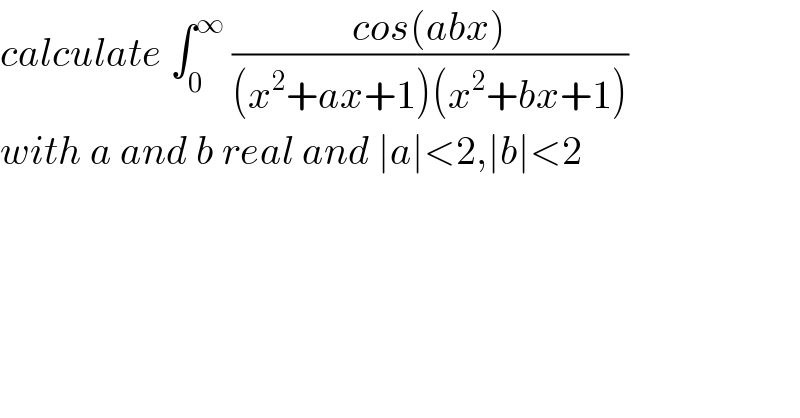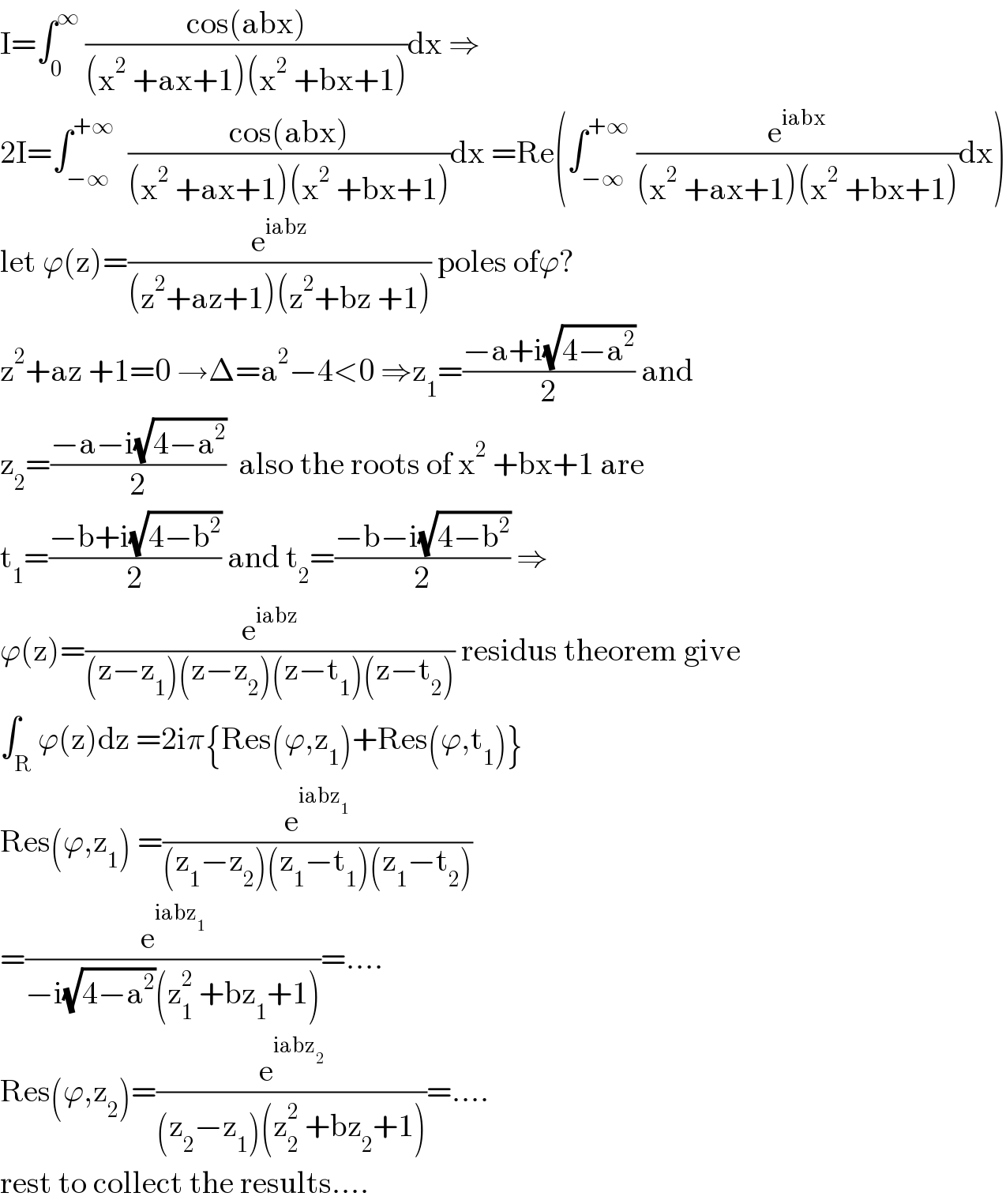
Question Number 130387 by Bird last updated on 25/Jan/21

$${calculate}\:\int_{\mathrm{0}} ^{\infty} \:\frac{{cos}\left({abx}\right)}{\left({x}^{\mathrm{2}} +{ax}+\mathrm{1}\right)\left({x}^{\mathrm{2}} +{bx}+\mathrm{1}\right)} \\ $$ $${with}\:{a}\:{and}\:{b}\:{real}\:{and}\:\mid{a}\mid<\mathrm{2},\mid{b}\mid<\mathrm{2} \\ $$
Commented bymathmax by abdo last updated on 25/Jan/21

$$\mathrm{the}\:\mathrm{q}.\mathrm{is}\:\int_{\mathrm{0}} ^{\infty} \:\frac{\mathrm{cos}\left(\mathrm{abx}\right)}{\left(\mathrm{x}^{\mathrm{2}} \:+\mathrm{ax}+\mathrm{1}\right)\left(\mathrm{x}^{\mathrm{2}} \:+\mathrm{bx}+\mathrm{1}\right)}\mathrm{dx} \\ $$
Commented bymathmax by abdo last updated on 25/Jan/21

$$\mathrm{I}=\int_{\mathrm{0}} ^{\infty} \:\frac{\mathrm{cos}\left(\mathrm{abx}\right)}{\left(\mathrm{x}^{\mathrm{2}} \:+\mathrm{ax}+\mathrm{1}\right)\left(\mathrm{x}^{\mathrm{2}} \:+\mathrm{bx}+\mathrm{1}\right)}\mathrm{dx}\:\Rightarrow \\ $$ $$\mathrm{2I}=\int_{−\infty} ^{+\infty} \:\:\frac{\mathrm{cos}\left(\mathrm{abx}\right)}{\left(\mathrm{x}^{\mathrm{2}} \:+\mathrm{ax}+\mathrm{1}\right)\left(\mathrm{x}^{\mathrm{2}} \:+\mathrm{bx}+\mathrm{1}\right)}\mathrm{dx}\:=\mathrm{Re}\left(\int_{−\infty} ^{+\infty} \:\frac{\mathrm{e}^{\mathrm{iabx}} }{\left(\mathrm{x}^{\mathrm{2}} \:+\mathrm{ax}+\mathrm{1}\right)\left(\mathrm{x}^{\mathrm{2}} \:+\mathrm{bx}+\mathrm{1}\right)}\mathrm{dx}\right) \\ $$ $$\mathrm{let}\:\varphi\left(\mathrm{z}\right)=\frac{\mathrm{e}^{\mathrm{iabz}} }{\left(\mathrm{z}^{\mathrm{2}} +\mathrm{az}+\mathrm{1}\right)\left(\mathrm{z}^{\mathrm{2}} +\mathrm{bz}\:+\mathrm{1}\right)}\:\mathrm{poles}\:\mathrm{of}\varphi? \\ $$ $$\mathrm{z}^{\mathrm{2}} +\mathrm{az}\:+\mathrm{1}=\mathrm{0}\:\rightarrow\Delta=\mathrm{a}^{\mathrm{2}} −\mathrm{4}<\mathrm{0}\:\Rightarrow\mathrm{z}_{\mathrm{1}} =\frac{−\mathrm{a}+\mathrm{i}\sqrt{\mathrm{4}−\mathrm{a}^{\mathrm{2}} }}{\mathrm{2}}\:\mathrm{and} \\ $$ $$\mathrm{z}_{\mathrm{2}} =\frac{−\mathrm{a}−\mathrm{i}\sqrt{\mathrm{4}−\mathrm{a}^{\mathrm{2}} }}{\mathrm{2}}\:\:\mathrm{also}\:\mathrm{the}\:\mathrm{roots}\:\mathrm{of}\:\mathrm{x}^{\mathrm{2}} \:+\mathrm{bx}+\mathrm{1}\:\mathrm{are} \\ $$ $$\mathrm{t}_{\mathrm{1}} =\frac{−\mathrm{b}+\mathrm{i}\sqrt{\mathrm{4}−\mathrm{b}^{\mathrm{2}} }}{\mathrm{2}}\:\mathrm{and}\:\mathrm{t}_{\mathrm{2}} =\frac{−\mathrm{b}−\mathrm{i}\sqrt{\mathrm{4}−\mathrm{b}^{\mathrm{2}} }}{\mathrm{2}}\:\Rightarrow \\ $$ $$\varphi\left(\mathrm{z}\right)=\frac{\mathrm{e}^{\mathrm{iabz}} }{\left(\mathrm{z}−\mathrm{z}_{\mathrm{1}} \right)\left(\mathrm{z}−\mathrm{z}_{\mathrm{2}} \right)\left(\mathrm{z}−\mathrm{t}_{\mathrm{1}} \right)\left(\mathrm{z}−\mathrm{t}_{\mathrm{2}} \right)}\:\mathrm{residus}\:\mathrm{theorem}\:\mathrm{give} \\ $$ $$\int_{\mathrm{R}} \varphi\left(\mathrm{z}\right)\mathrm{dz}\:=\mathrm{2i}\pi\left\{\mathrm{Res}\left(\varphi,\mathrm{z}_{\mathrm{1}} \right)+\mathrm{Res}\left(\varphi,\mathrm{t}_{\mathrm{1}} \right)\right\} \\ $$ $$\mathrm{Res}\left(\varphi,\mathrm{z}_{\mathrm{1}} \right)\:=\frac{\mathrm{e}^{\mathrm{iabz}_{\mathrm{1}} } }{\left(\mathrm{z}_{\mathrm{1}} −\mathrm{z}_{\mathrm{2}} \right)\left(\mathrm{z}_{\mathrm{1}} −\mathrm{t}_{\mathrm{1}} \right)\left(\mathrm{z}_{\mathrm{1}} −\mathrm{t}_{\mathrm{2}} \right)} \\ $$ $$=\frac{\mathrm{e}^{\mathrm{iabz}_{\mathrm{1}} } }{−\mathrm{i}\sqrt{\mathrm{4}−\mathrm{a}^{\mathrm{2}} }\left(\mathrm{z}_{\mathrm{1}} ^{\mathrm{2}} \:+\mathrm{bz}_{\mathrm{1}} +\mathrm{1}\right)}=.... \\ $$ $$\mathrm{Res}\left(\varphi,\mathrm{z}_{\mathrm{2}} \right)=\frac{\mathrm{e}^{\mathrm{iabz}_{\mathrm{2}} } }{\left(\mathrm{z}_{\mathrm{2}} −\mathrm{z}_{\mathrm{1}} \right)\left(\mathrm{z}_{\mathrm{2}} ^{\mathrm{2}} \:+\mathrm{bz}_{\mathrm{2}} +\mathrm{1}\right)}=.... \\ $$ $$\mathrm{rest}\:\mathrm{to}\:\mathrm{collect}\:\mathrm{the}\:\mathrm{results}.... \\ $$
